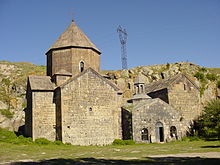Wanewan Monastery
The monastery Wanewan ( Armenian Վանեվանի վանք Wanewani Wank ) is a former convent of the Armenian Apostolic Church in the eastern Armenian province of Gegharkunik . The origins of the monastery go back to the 10th century. Today it is partly a ruin.
location
The monastery is located southeast of Lake Sevan on the southern edge of the village of Artsvanist . About three kilometers south the church are Kolataki Surb Astvatsatsin ( Armenian Սուրբ Աստվածածին , "Holy Mother of God "), Western Armenian Surp Asdwadsadsin , other transcriptions Surp Astvatsatsin, Surb Astuacacin, Surb Astwazazin from the late 9th to the early 10th century and the monastery Hnewank from the 10th century. The Bruti Berd fortress with its Cyclops masonry is also nearby .
Building description
The monastery complex consists of two churches, a gawit in between , which are all covered with a similar gable roof. All three buildings face east. Behind the monastery there is a spring and a small cave that leads to the top of the mountain and possibly served as an escape route for the monastery residents. The main church Surb Grigor , built in 907, is a four - armed cross -domed church with four semicircular apses . There are two side rooms on the east side. The tambour is octagonal both inside and outside and is crowned by a pyramid roof, which is now damaged. Four central arches support the tambour and the tent roof. The walls of the church were built of basalt plain, while the inner walls of the drum with carefully worked tuff blinded is. The only decorative element on the inside of the tambour is a surrounding band in the lower area.
The church opposite is possibly the same age. It is a single-nave church with an elongated floor plan. Its barrel vault, which has now partially collapsed, was supported by a series of arches. Two vaulted niches were carved into the side walls. The circumferential band at the foot of the dome is identical to that of the main church, so that it is assumed that both churches are the same old. Its walls are covered with a layer of paint of unknown age.
The intermediate gawit was added later. The building connects the churches and is covered with a cantilever vault with a central skylight. Today it is partially destroyed. Through an opening in the east wall of the Gawit, two rectangular side rooms can be entered, which may have been monk cells .
There are several khachkars in the monastery and in the vicinity . In the vicinity of the monastery there is an abandoned cemetery and the ruins of another church.
history
Not much is known about the history of Wanewan Monastery. According to an inscription on the south-eastern side of the drum, the brother of King Smbat (the second king of the medieval Armenian Kingdom), Prince Shapuh Bagratuni, and his sister Mariam, of the Armenian Bagratiden family, left the main church Surb Grigor ( Gregory the Illuminator , Armenian Գրիգոր Լուսաւորիչ , translit. Grigor Lusavorich , ancient Greek Γρηγόριος Φωστήρ Gregorios Phoster or Φωτιστής Photistés ; * probably around 240 ; † around 331 ) built in 903. As the inscription goes on to say, the monastery was then set up and given by local nobles with four surrounding villages and a water mill.
In 914, King Smbat I, who died fighting Arab invaders, was buried in the Wanewan Monastery.
According to the medieval historian and metropolitan of Sjunik , Stepanos Orbelian ( Armenian Ստեփանոս Օրբելյան ; approx. 1250-1305) the monastery was in the late 10th / early 11th century, the monastery was apparently so dilapidated that Gagik I, of 989-1020 King of Armenia , restored and surrounded with a wall.
After several campaigns by the Ottoman Empire , the area around the monastery was largely depopulated in the 16th century. The monks also left the monastery, which was then abandoned. In the second half of the 19th century it was reoccupied. In the years 1871-80 the monastery, which is still active today, was restored.
Web links
Individual evidence
- ↑ a b c d e f g h VANEVAN. August 29, 2012. Retrieved November 10, 2017 .
- ↑ a b Vanevan Monastery - Armeniapedia.org. Retrieved November 10, 2017 . (Copy from: Raffi Kojian: Rediscovering Armenia: an archaeological / touristic gazetteer and map set for the historical monuments of Armenia. Tigran Mets, Yerevan 2001, ISBN 99930-52-28-0 )
- ↑ Vanevan Monastery. (No longer available online.) Archived from the original on November 10, 2017 ; accessed on November 10, 2017 . Info: The archive link was inserted automatically and has not yet been checked. Please check the original and archive link according to the instructions and then remove this notice.
Coordinates: 40 ° 8 ′ 47.4 " N , 45 ° 30 ′ 55.8" E


